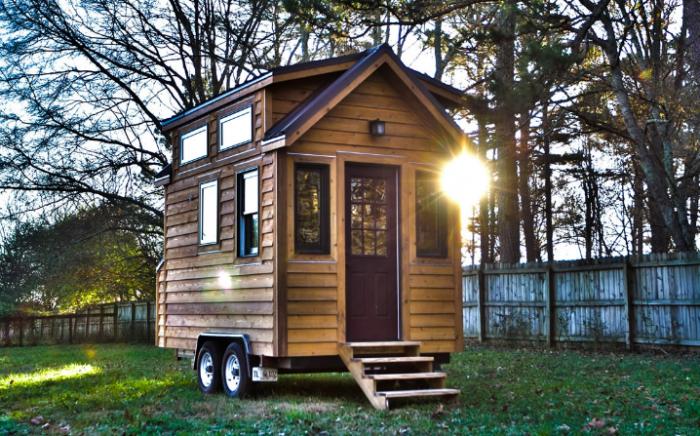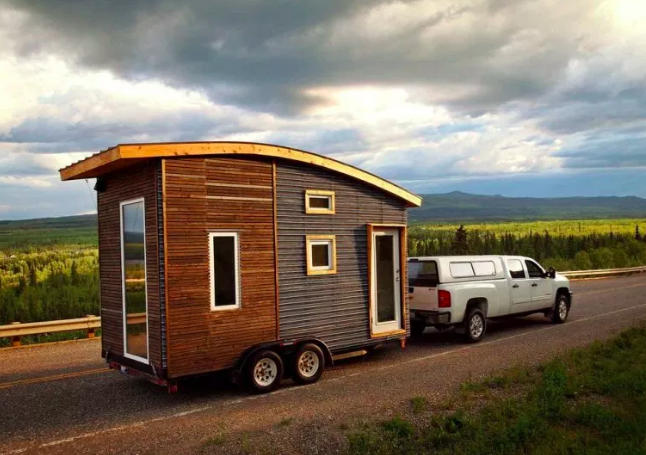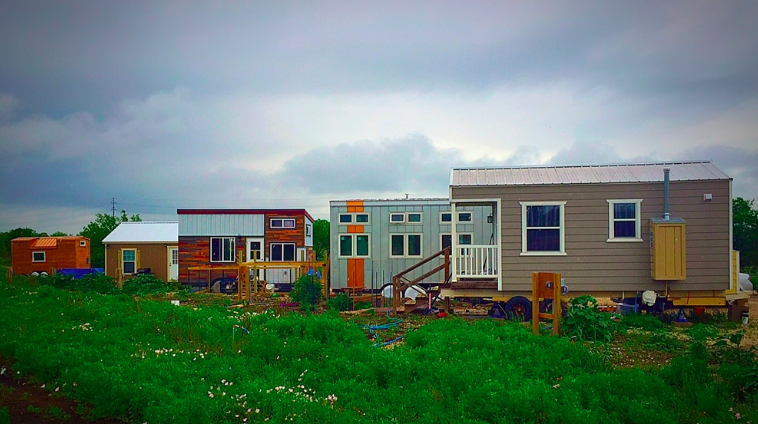
According to the US Census Bureau, the median size of a new single-family home sold in 2018 was 2,435 square feet. A Tiny Home, on the other hand, ranges from as small as 80 square feet, to 400 square feet. Houses use enormous amounts of energy and resources - from construction, to upkeep, to everyday use. And likewise the larger the house, the more they use; hence the rise of the Tiny House. Tiny Homes allow the homeowner to decrease their living space, energy use, building costs, and living costs, all while simplifying their lifestyle. This lifestyle provides a contrast, and sometimes a statement against, the typical image of a dream home - a mansion that guzzles gas, electricity, and dollars at an incredible speed. While living in a Tiny Home is a great move for environmental purposes, people also choose the Tiny life to save money, to declutter and simplify their lives, to be more mobile or flexible, or as a convenient solution to living alone.
Tiny Houses serve many purposes, and their popularity is on the rise. So then, why haven’t you seen more Tiny Houses near you? Good things don’t always come easy, including Tiny Houses. While there are countless perks of Tiny Homes, there are also complications and obstacles. Among the main obstacles keeping Tiny Houses from popping up everywhere are the restrictive zoning laws that can make building or finding land for a Tiny House extremely difficult. According to Alexis Stephens, the national coordinator for the Tiny House Association and the producer of Tiny House Expedition, "There’s a lot of interest [in tiny living], but people are confused by the zoning codes and regulations, and feel intimidated to go to the city government." (https://www.tinysociety.co/articles/tiny-house-laws-united-states/)
While acknowledging the difficulty of zoning laws for many aspiring tiny house owners, this article aims to explain zoning transparently, with the idea in mind that the way to get around them is not to argue, but to understand, adapt, and where possible work for change - one house at a time, or through change at the community level.
The first issue with zoning is how to define a Tiny Home. Between the two different types, (on a foundation or on wheels) the definitions are largely different. This makes zoning laws not simply an issue of size, but adds a layer of type. Tiny Houses on wheels (sometimes called THOWs) are often grouped in with trailers, and considered ‘recreational,’ therefore assuming the unit is not the owner’s permanent home. In this case, the owner cannot list their tiny home as their permanent address, as they are expected to be mobile and often not allowed to live in the ‘vehicle’ on one plot of land for over thirty days.

Image: lovelydwellings.com, via viewpointcloud.com
Similarly to Tiny Homes being considered vehicles, the small size of many of these homes categorizes them as what are called ADUs, or Accessory Dwelling Units. This is a term for buildings that zoning laws deem too small to be a primary residence, and therefore must be an ‘accessory,’ similar to the recreational categorization. The size limit in these definitions derive from minimum size requirements that are included in many zoning laws, in order to keep neighborhoods consistent. The idea here is that no house strays too far from the norm, creating some unifornity of housing type, size, use or other characteristics - which are almost by definition the reasons zoming laws were created in the first place. While these laws seem to strive towards ease and assure residents they will not have to step outside of their comfort zones or expectations, this type of minimum size requirement is largely a historically carried rule that could be overturned if enough people and their represenatives are receptive to change.
The size of a Tiny Home also becomes an issue with taxes. A second reason for minimum size requirements or the ‘ADU’ classification is that such a small size for a home evades most standard categorizations in tax forms. In other words, many governments have not yet figured out a label or a box for Tiny Houses to fall into on tax forms, other than labeling them as accessories, or not acknowledging or allowing them all together. Letting people put Tiny Homes on the properties of friends or neighbors and sharing utilities means less taxable properties, and less money for the government. Put this way, it’s easy to see why Tiny Homes may seem like loopholes or tax-dodging to the makers of the zoning laws and local governments.

Image: tinyhouseexpedition.com via www.viewpointcloud.com
While the logic behind these zoning challenges does have some merit, especially with historical perspective and understanding that change isn't always easy or quick, it’s clear that they can often make building or owning a tiny house extremely - and perhaps unreasonably- difficult. The good news is that more cities and towns are starting to amend zoning laws and regulations to allow tiny houses. In addition to the environmental and lifestyle benefits mentioned for homeowners, municipal positives include:
- Increasing the amount of more affordable housing
- Increasing the tax base (once taxation challenges are resolved) and supporting the local economy
- Additional housing
- Increased population
- Helping more families accommodate older relatives who wish to live near or with family
- Resolving conflict and creating win-wins instead, especially where tiny house owners are not following regulations
The path if least resistance might be the most obvious solution. Those who wish to build tiny homes might simply be to build where coming laws are already more lenient, or accepting of Tiny Houses.
For a state by state guide of tiny house acceptance and compliance with building codes, visit:
https://www.tinysociety.co/articles/tiny-house-laws-united-states/
Where are more tiny houses located? See this self reported map of tiny home owners:
https://www.tinyhomebuilders.com/map
Another path would be to seek exceptions or to change the rules. Homeowners can ask municipalities for a single exception, or zoning variance, for the non-conforming home they wish to build. Variances can be easier to obtain in some jurisdictions than others, and the amount of time to apply for one can also vary widely. Changing the rules might not be an option for a homeowner in a hurry, but those seeking to pursue the tiny home life can also join and support what seems to be an increasing movement to change zoning laws in favor of greater tiny house acceptance.
Examples of zoning changes that might resolve tiny housing obstacles as reviewed include:
- Explicitly define and plan for tiny houses in local codes
- Change minimum dwelling sizing requirements
- Address any challenges posed by dwellings on wheels or smaller houses causing classification issues
- Consider licensing where dwelling definitions are not easily changed
- Address square footage and setback restrictions that could unreasonably prevent tiny houses
- Consider occupancy and not square footage limits on property by size
- Allow tiny houses in specific areas or on properties of a certain minimum size
- Allow tiny houses for specific uses, such as affordable housing or for certain occupants, like an older relative
To read about petitioning your local or state government for changes in tiny house related regulations, visit:
https://americantinyhouseassociation.org/how-to-initiate-tiny-house-friendly-zoning-changes/
According to realestateagent.com, the top 5 tiny house-friendly states are: California, Florida, Colorado, Oregon and Texas. For more detail: https://www.realestateagent.com/real-estate-questions/what-states-allow-tiny-houses.html
To learn more about Tiny House zoning laws, visit:
https://www.tinyhomebuilders.com/help/tiny-house-movement
https://www.aarp.org/livable-communities/housing/info-2015/tiny-houses-are-becoming-a-big-deal.html
https://thetinylife.com/tiny-house-building-codes/
https://www.tinysociety.co/articles/tiny-house-laws-united-states/
https://www.realtor.com/advice/buy/tiny-house-building-zoning-legalities/
Thumbnail Image Source: tinyhomebuilders.com
- Filed Under: Tiny Houses
- ( 25586 ) views
- ( 0 ) Ratings
- ( 0 ) Discussions
- ( 0 ) Group Posts
Reply/Leave a Comment (You must be logged in to leave a comment)
Connect with us!
Subscribe to our monthly newsletter:
 Greenbuild Report Out, 2025 Nov 12, 2025
Greenbuild Report Out, 2025 Nov 12, 2025































Not a Member Yet? Register and Join the Community | Log in